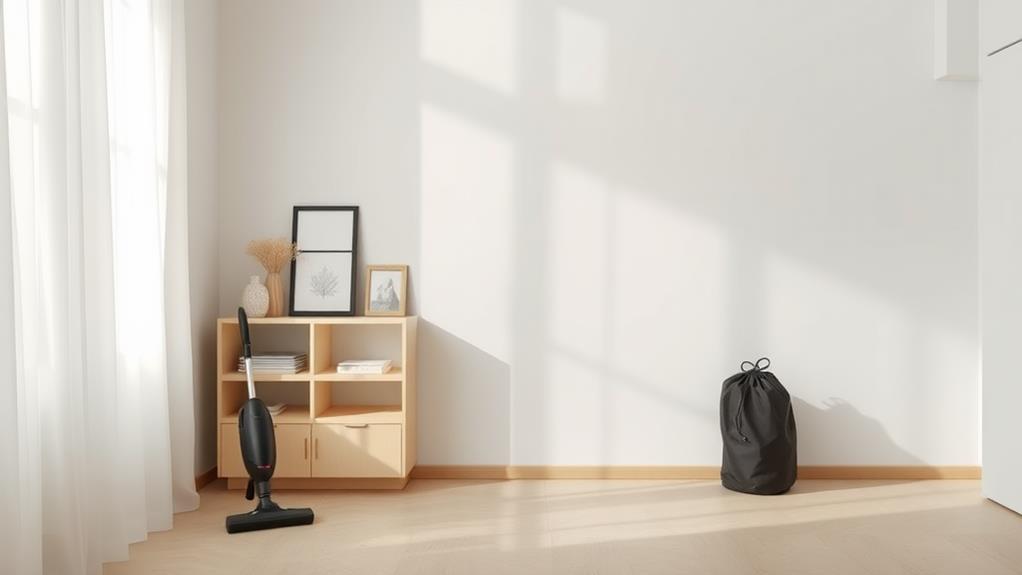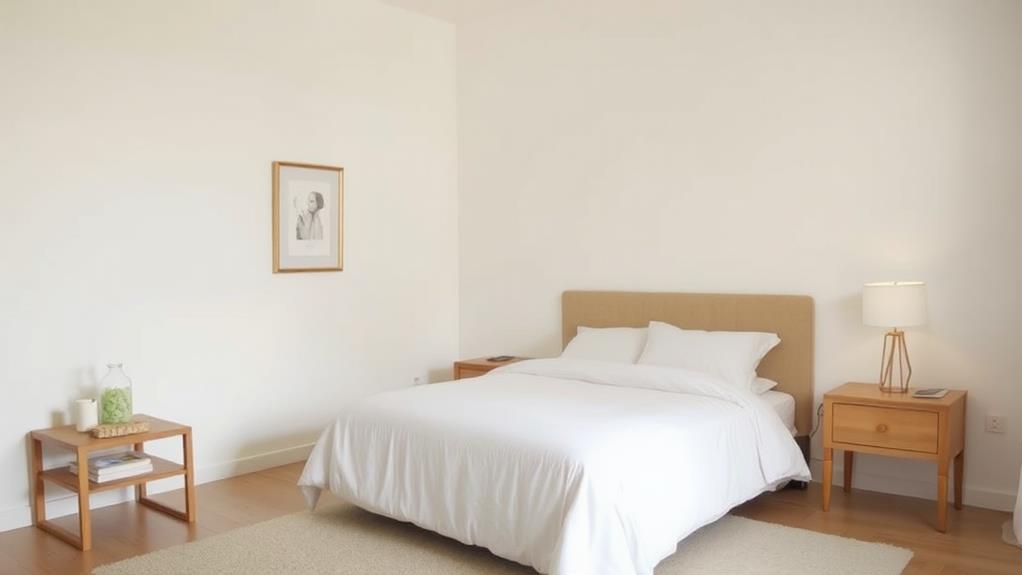To declutter everything in your home, start by setting clear goals and prioritizing areas based on urgency. Tackle one room at a time using a sorting system: keep, donate, sell, or discard. Embrace a minimalist mindset; only hold onto items that truly add value. Involve family members for support and motivation. Consider storage solutions, like bins and shelves, to maximize your space. Establish daily cleaning rituals to maintain your progress. With a structured approach, you'll create a serene environment. There are plenty of strategies to explore, ensuring your decluttering journey remains effective and rewarding.
Summary
- Set clear decluttering goals and create a manageable plan to tackle one room at a time.
- Utilize a sorting system to categorize items into keep, donate, sell, and discard.
- Involve family members in the decluttering process for a collaborative effort.
- Regularly assess and organize seasonal items to maintain a clutter-free environment year-round.
- Establish daily cleaning rituals to prevent clutter from accumulating and to keep spaces tidy.
Understanding the Benefits of Decluttering
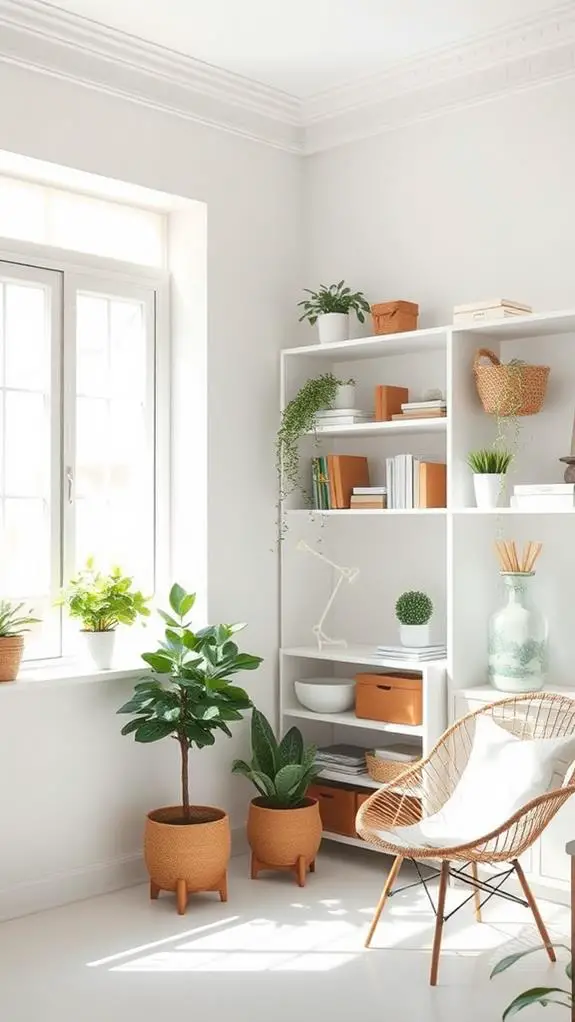
Decluttering your home not only creates a more organized space but also brings a wealth of benefits that can enhance your overall well-being.
When you clear out unnecessary items, you'll experience a boost in mental clarity. A tidy environment allows your mind to focus better on tasks at hand, reducing stress and distractions.
You'll find that emotional freedom follows, as letting go of physical clutter often correlates with freeing yourself from emotional baggage.
This newfound space in your home can inspire creativity and innovation, fostering a positive mindset.
As you navigate this process, remember that each item you release opens the door for new possibilities, helping you cultivate a more vibrant and fulfilling life.
Embrace the change; it's transformative.
Getting Started With a Plan
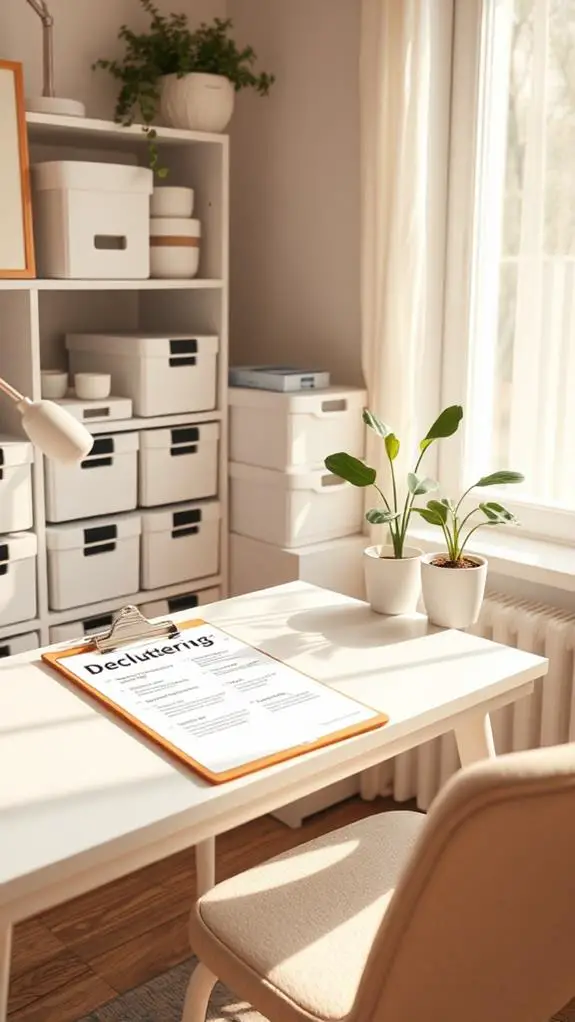
To kick off your decluttering journey, start by setting clear goals for what you want to achieve.
Next, prioritize which areas of your home need the most attention, and create a plan for tackling them.
Set Clear Goals
Setting clear goals is essential for an effective decluttering process. Start by implementing goal setting techniques that resonate with your unique circumstances.
Define what you want to achieve—whether it's clearing out a closet or an entire room. Break these goals into smaller, manageable tasks, ensuring they lead to measurable outcomes.
For instance, aim to remove ten items each day or designate a specific time block for decluttering. This approach not only keeps you motivated but also allows you to track progress effectively.
Prioritize Areas First
When tackling a decluttering project, it's crucial to prioritize the areas that need your attention most.
Begin with an area assessment to identify spaces that cause you the most stress or hinder your daily routine. Use priority settings to categorize these areas based on urgency and impact. For instance, start with high-traffic zones like the living room or kitchen, where clutter accumulates quickly.
Once you've pinpointed these critical areas, create a structured plan to tackle them one at a time. This method not only streamlines your efforts but also guarantees you're making noticeable progress.
Schedule Decluttering Sessions
After identifying the most critical areas in your home, the next step is to create a schedule for your decluttering sessions.
A well-structured decluttering schedule helps you manage your time effectively, ensuring you tackle each area without feeling overwhelmed. Start by allocating specific days and times for each session, breaking tasks into manageable chunks.
For instance, dedicate one hour to your closet on Saturday and another to your kitchen on Wednesday. Stick to your plan, but be flexible if unexpected challenges arise.
Keep track of your progress and adjust your schedule as needed to maintain momentum. By prioritizing time management, you'll find decluttering becomes a rewarding and innovative process rather than an intimidating task.
Setting Decluttering Goals
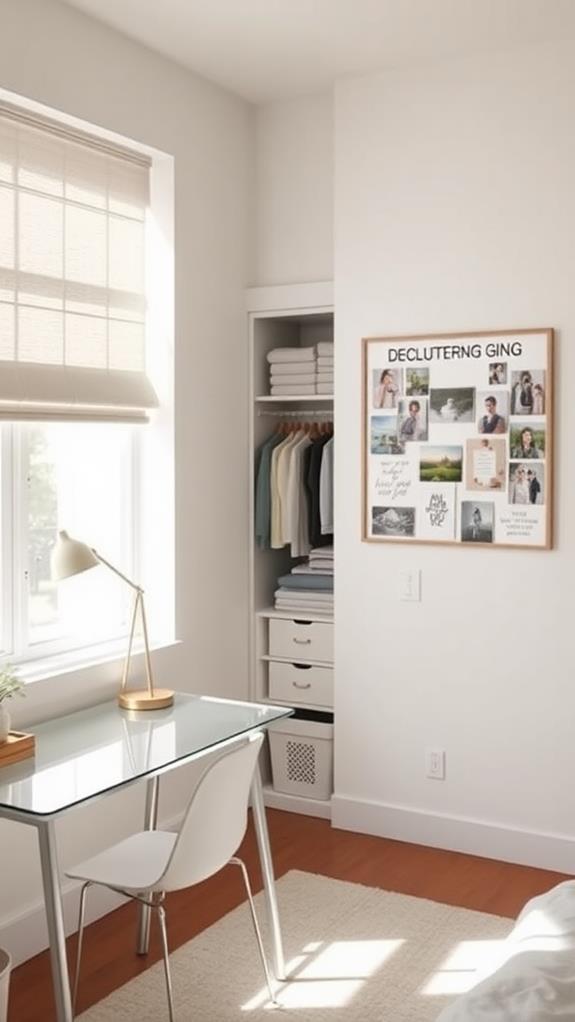
Establishing clear decluttering goals is essential for a successful and efficient process. Start by visualizing your ideal space; this goal visualization helps focus your efforts.
Break down your larger objectives into smaller, manageable tasks. For example, aim to declutter one room or area at a time. Use motivational quotes to inspire you along the way—something like, "The best time to start was yesterday; the second-best time is now."
Set deadlines for each task to keep yourself accountable and track your progress. Remember, it's not just about getting rid of things; it's about creating a space that reflects your values and lifestyle.
With these goals in place, you'll find it easier to stay motivated and committed to the process.
Room-by-Room Decluttering Approach
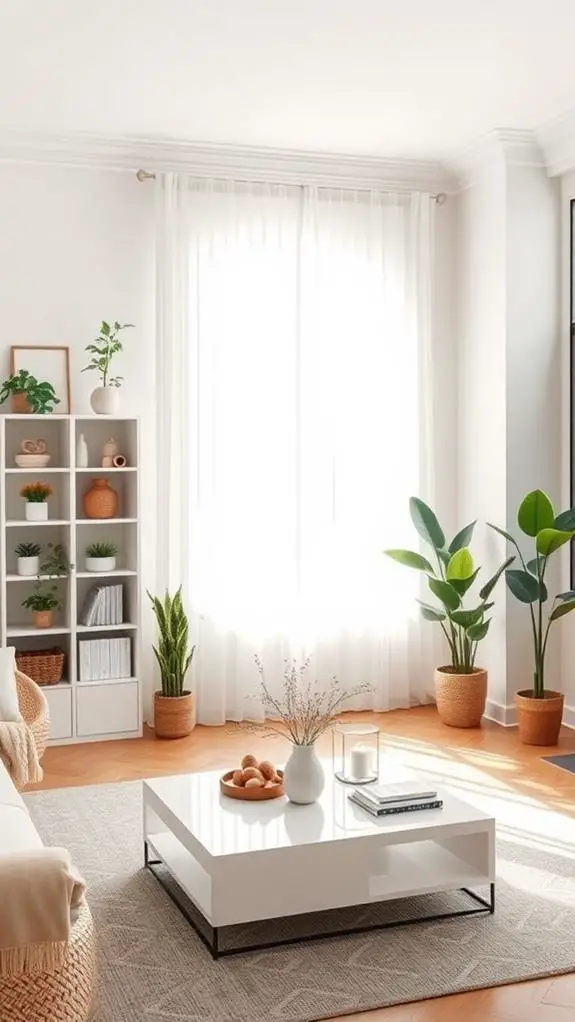
Tackling decluttering room by room can make the process feel less overwhelming and more achievable.
Start by evaluating room layouts and identifying areas that need attention. Use effective decluttering techniques, like sorting systems, to categorize items based on necessity and emotional attachments.
Embrace a minimalist mindset as you decide what to keep or let go. Involve family members to share the workload, making it a collaborative effort.
Implement donation strategies for items in good condition and explore recycling options for the rest.
Prioritize time management by dedicating specific blocks of time for each room, utilizing decluttering tools like bins and labels to streamline the process.
This structured approach guarantees progress without the chaos.
Kitchen Decluttering Tips
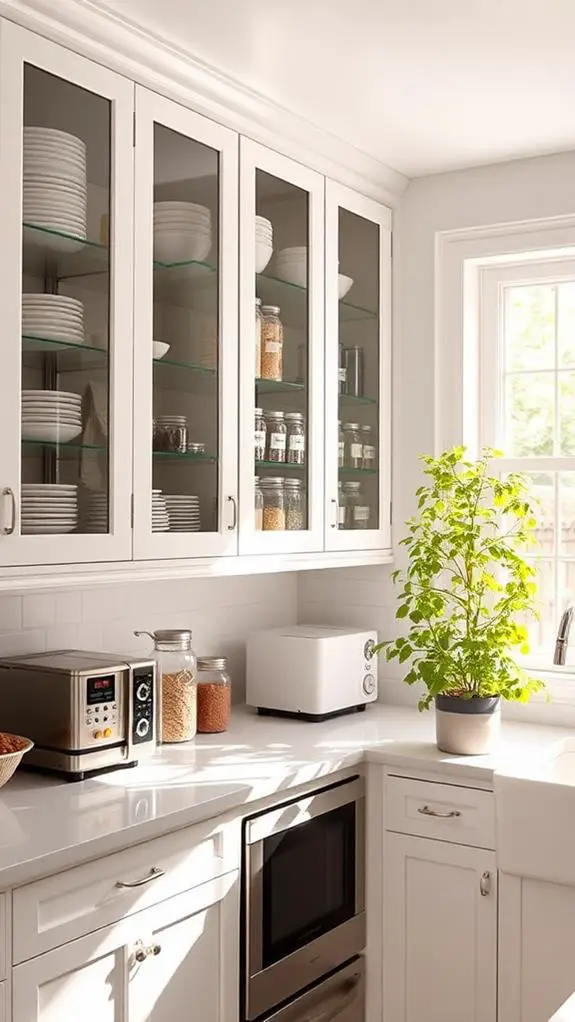
The kitchen often becomes a catch-all for miscellaneous items, making it one of the trickiest areas to declutter. Start by tackling countertop clutter; keep only cooking essentials and a few decorative items.
Then, focus on utensil arrangement—group similar gadgets together for easy access. Organize your pantry by checking food expiration dates, discarding expired items, and categorizing remaining products.
For dish storage, use clear containers to maximize space. Next, streamline appliance management by storing infrequently used gadgets away and keeping daily tools accessible.
Living Room Organization Strategies
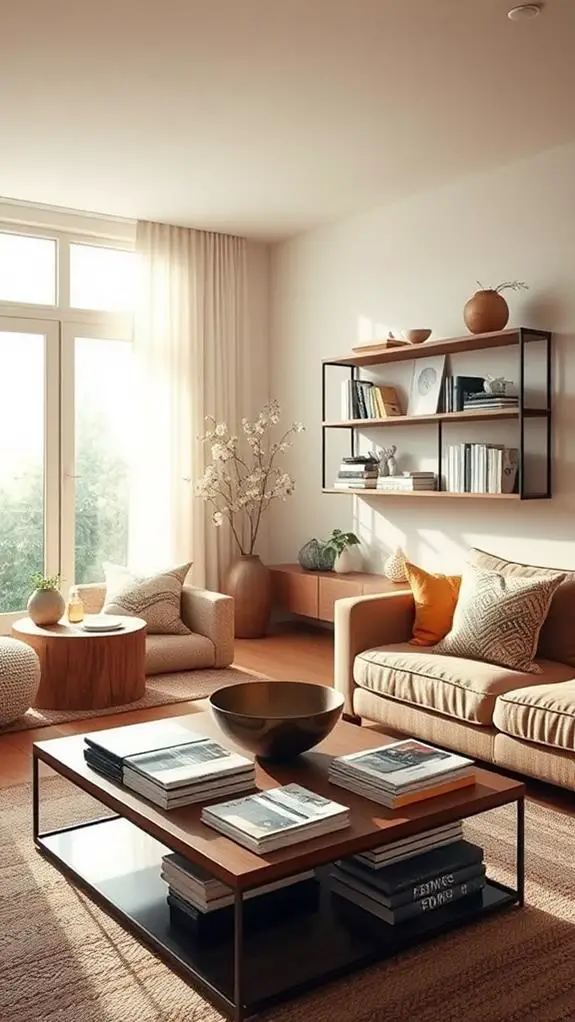
To effectively organize your living room, start by evaluating your space and identifying what you need and don't need.
Once you've got a clear picture, consider using storage solutions that fit your style and maximize functionality.
This approach will help create a more inviting and clutter-free environment.
Assess Your Space
Evaluating your living room is the first step toward effective organization.
Begin with a thorough space evaluation, focusing on how you use each area. Identify key zones—relaxation, entertainment, and storage.
Next, conduct a clutter assessment; look for items that don't belong or serve a purpose. Ask yourself if each piece enhances your living experience.
Consider the flow of movement; can you navigate comfortably? Are there surfaces overrun with items?
Take notes on what needs to change. This methodical approach helps you visualize potential improvements and prioritize what to declutter.
Use Storage Solutions
Incorporating effective storage solutions can transform your living room into a more organized and functional space. Start by identifying areas where smart storage can be utilized.
Consider multi-functional furniture, like ottomans with hidden compartments or coffee tables with shelves. These creative solutions not only save space but also enhance your decor.
Next, use vertical space by adding wall-mounted shelves or tall bookcases, allowing you to display items while keeping the floor clear. Baskets and decorative boxes can also neatly store miscellaneous items, blending style with practicality.
Bedroom Decluttering Techniques
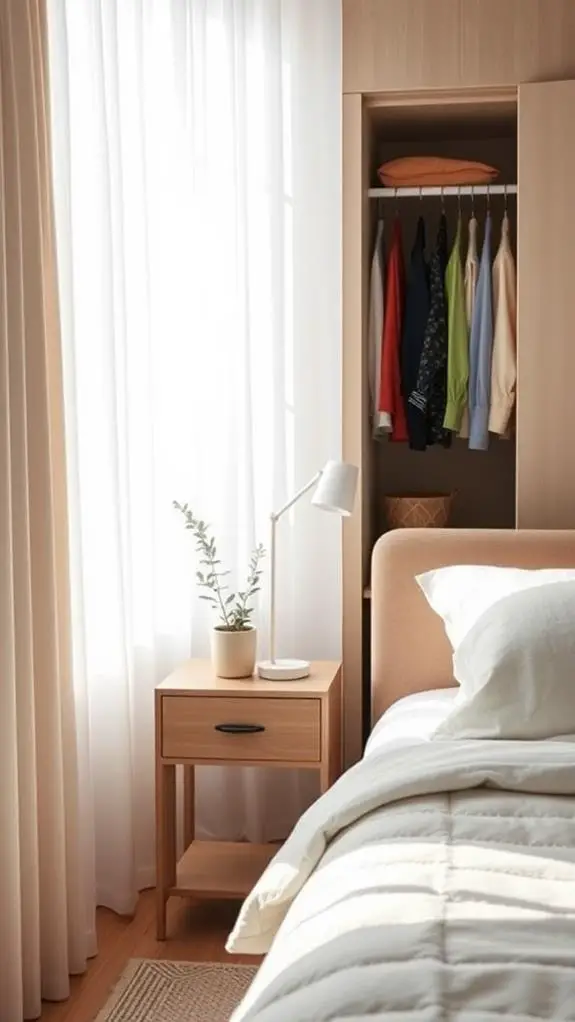
When tackling bedroom decluttering, start by setting clear goals for what you want to achieve. Focus on maximizing bedroom storage while embracing minimalist decor.
Begin with closet organization; sort through clothes and implement a wardrobe rotation to keep only what you wear regularly. For sentimental items, decide if they truly enhance your personal space or if they can be stored away.
Streamline your nightstand essentials—keep only what you use nightly.
Finally, prioritize bedding management; rotate and store linens efficiently to avoid clutter.
By applying these techniques, you'll create a serene bedroom environment that reflects your style and promotes relaxation.
Bathroom Simplification Methods
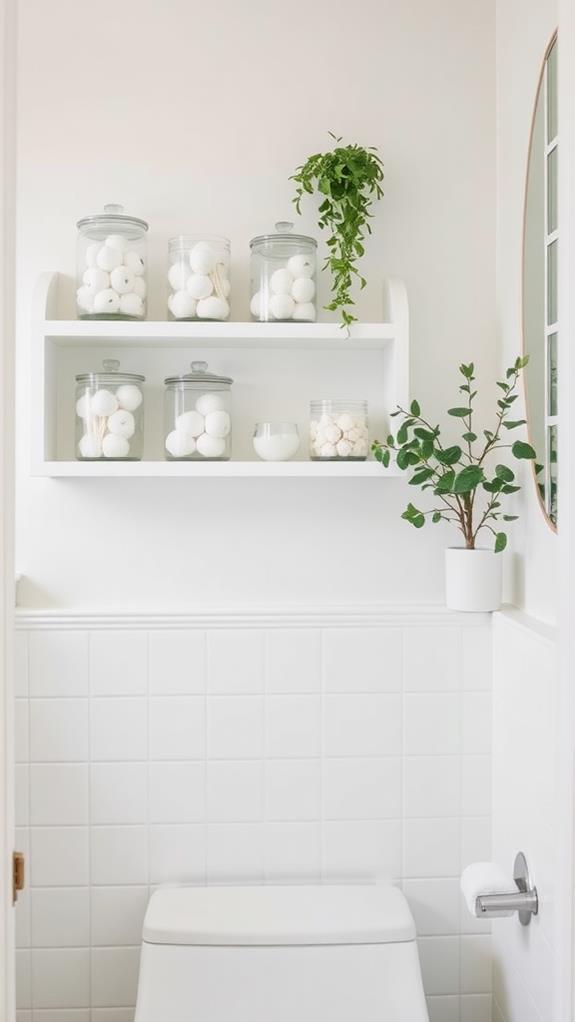
A well-organized bathroom can transform your daily routine and create a calming atmosphere. Start by implementing effective toiletry storage solutions, like clear bins or drawer dividers, to keep personal care items in order.
Check for product expiration dates regularly and dispose of any expired items responsibly. For medicine organization, use labeled containers to make everything easily accessible.
Cleaning supply management is essential; opt for multi-purpose products that save space and align with sustainable practices.
Embrace minimalistic decor by choosing aesthetically pleasing arrangements that enhance visual appeal without clutter.
Finally, consider donation options for any unused or gently used items, allowing someone else to benefit while you simplify your space.
Embrace these methods for a streamlined, functional bathroom.
Home Office Decluttering Hacks
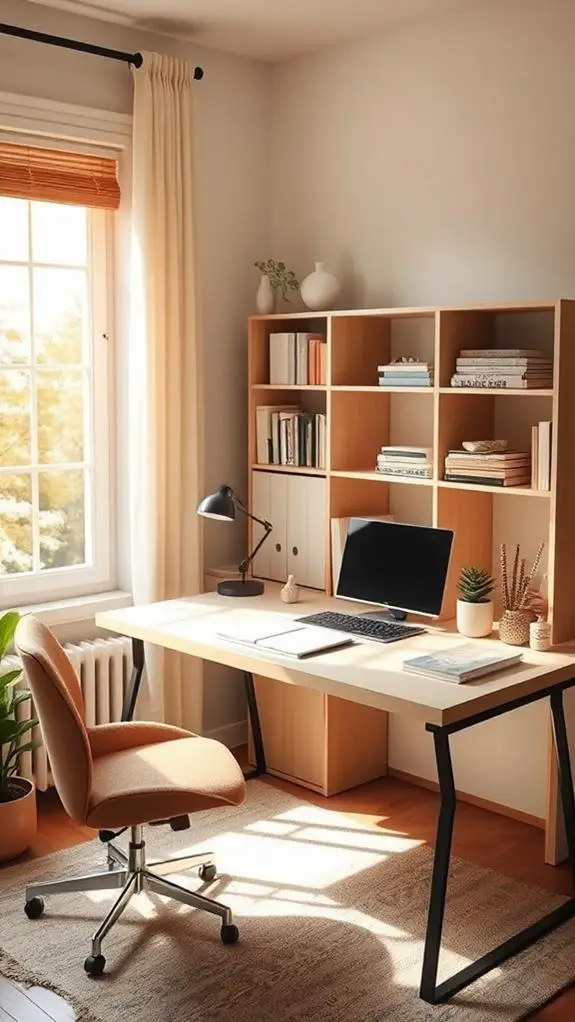
How can you create a more productive and inspiring home office environment? Start by prioritizing home office organization. Clear your desk of unnecessary items—only keep essentials within reach. Use drawer organizers to separate supplies, and consider digital solutions for documents to minimize paper clutter.
Next, evaluate your workspace efficiency. Utilize vertical storage—shelves or wall-mounted organizers can free up desk space. Invest in cable management solutions to keep cords tidy and out of sight.
Lastly, implement a "one in, one out" policy for new items to maintain your decluttered space. Regularly assess your office layout and functionality to guarantee it aligns with your needs.
A streamlined office promotes creativity and productivity, transforming your work experience.
Garage and Basement Cleanup
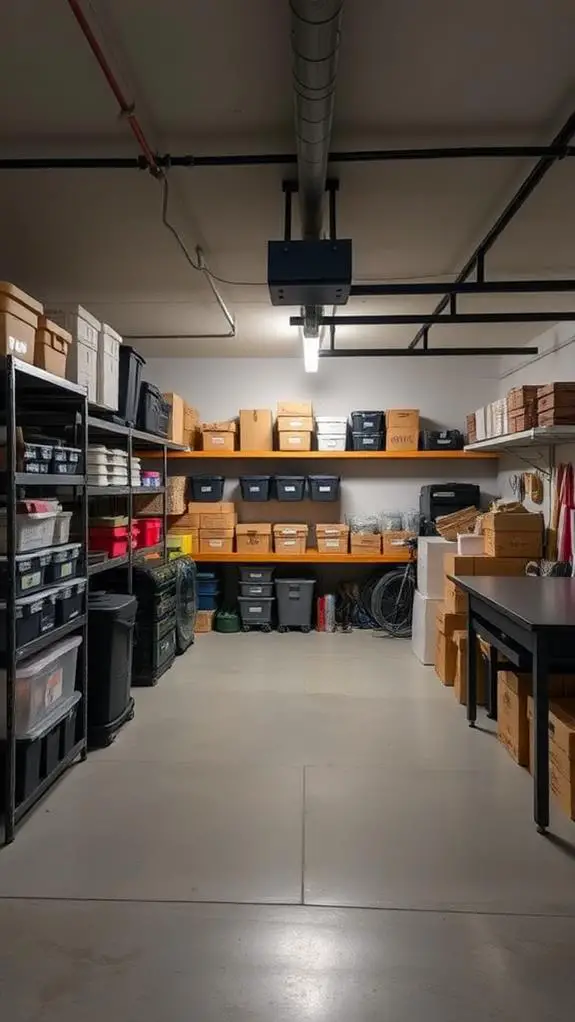
Many homeowners find their garages and basements overflowing with items that no longer serve a purpose. To tackle this, start by sorting everything into categories: keep, donate, sell, and discard.
Focus on garage organization by using shelving units and clear bins to maximize vertical space. This not only streamlines access but also creates a more functional environment.
For basement storage, consider modular storage solutions that adapt to your needs. Label each bin clearly to make retrieval easy, and regularly reassess your items to prevent future clutter.
Maintaining a Clutter-Free Home
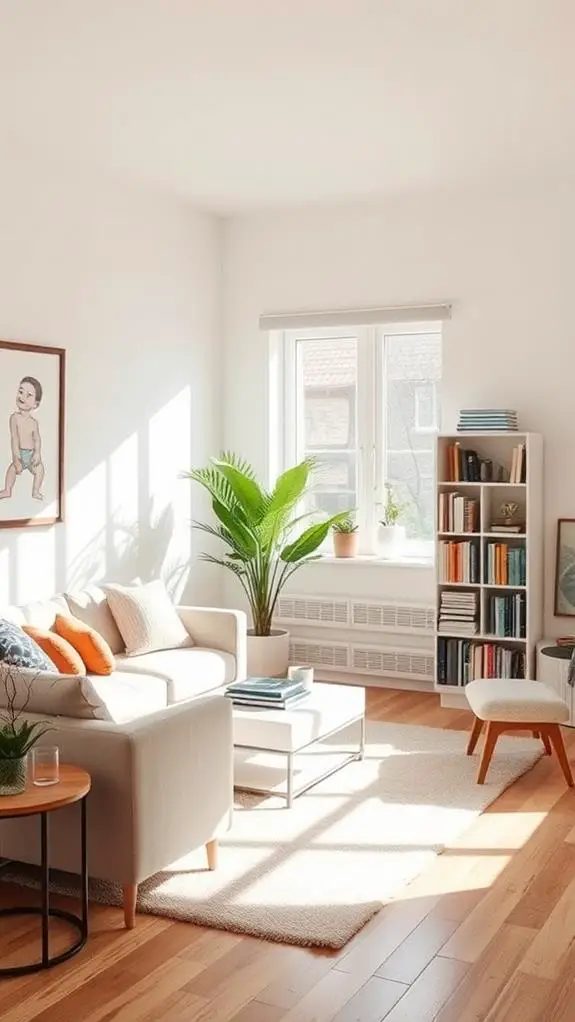
To keep your home clutter-free, establish daily cleaning rituals that fit into your routine.
Regularly organizing seasonal items can also help maintain order and prevent accumulation.
Daily Cleaning Rituals
Creating daily cleaning rituals can be a game-changer in maintaining a clutter-free home. Start by establishing simple cleaning routines that you can easily incorporate into your daily habits. For instance, dedicate just 10 minutes each morning to tidy up surfaces or put away items that don't belong.
In the evenings, take another 10 minutes to assess common areas—empty the trash, fluff the pillows, and wipe down counters. These small but consistent actions prevent clutter from piling up.
Consider using a checklist to track your daily tasks, ensuring nothing slips through the cracks. By committing to these daily cleaning rituals, you'll cultivate a fresh, organized environment, making it easier to enjoy your space without the burden of clutter.
Organizing Seasonal Items
As daily cleaning rituals help maintain a tidy space, organizing seasonal items is another key step in keeping your home clutter-free.
Start by designating specific areas for seasonal storage, such as bins or closets, ensuring easy access throughout the year. When the season changes, perform an item rotation: remove items no longer in use and replace them with seasonal essentials.
Label each container clearly to streamline the process, preventing confusion and saving time later. Regularly evaluate your seasonal items—consider donating or discarding anything you haven't used in the past year.
This proactive approach not only keeps your space organized but also fosters a fresh and inviting atmosphere, allowing you to fully enjoy each season without the burden of clutter.
Resources for Decluttering Support
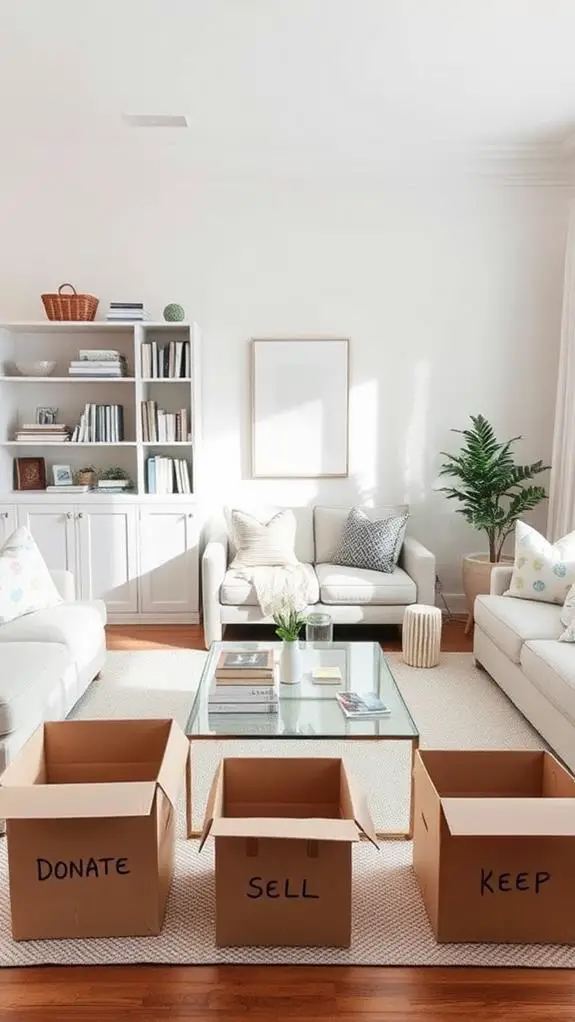
Finding the right decluttering support can make all the difference in your journey to an organized home. Start by exploring decluttering apps that track your progress and set goals.
Join support groups or participate in online forums where you can share experiences and gain insights. Minimalist blogs often offer practical tips and motivation techniques to keep you inspired.
Consider hiring professional organizers who can provide tailored advice and hands-on assistance. Community workshops can also foster collaboration and accountability, making decluttering a shared experience.
FAQs
How Do I Handle Sentimental Items While Decluttering?
Handling sentimental items can be tough, but you can use memory preservation strategies to make it easier.
Start by selecting a few key pieces that truly resonate with you. For the rest, consider taking photos to create a digital archive, allowing you to let go of the physical items.
Store the chosen items in a designated sentimental item storage box. This way, you keep the memories without feeling overwhelmed by clutter.
What Should I Do With Items I Want to Sell?
If you've got items you want to sell, start by evaluating their condition and value.
Consider listing them on online marketplaces like eBay or Facebook Marketplace for a wider reach. Create attractive photos and detailed descriptions to entice buyers.
Alternatively, you might host a garage sale to engage your local community. Price items reasonably and be ready to negotiate.
This approach helps you declutter while making some extra cash.
How Can I Involve My Family in the Decluttering Process?
To involve your family in the decluttering process, start by sharing your decluttering strategies with them.
Organize a family meeting to discuss the benefits of decluttering, making it a collective goal.
Assign specific areas or tasks to each family member to foster ownership.
Use fun challenges or rewards to keep everyone motivated.
Is It Okay to Declutter Items I Borrowed From Others?
It's okay to declutter borrowed belongings, but communication's key.
First, reach out to the owner and explain your intentions. Use clear communication strategies to express your thoughts and offer to return the items or discuss their fate.
If they're not needed anymore, suggest alternatives, like donating them.
This approach respects the relationship while also allowing you to create a more organized space.
After all, keeping things streamlined benefits everyone involved.
How Often Should I Revisit My Decluttering Efforts?
You should revisit your decluttering efforts regularly to maintain a clutter-free space.
Establish a decluttering schedule that works for you—monthly or seasonally is a good start. During these sessions, assess what you've kept and what needs to go.
This decluttering maintenance guarantees your space remains functional and fresh. Stay innovative by trying new methods or tools each time, keeping the process engaging and effective for your evolving needs.
Conclusion
Decluttering your home isn't just about tidying up; it's a path to a more peaceful and organized life. By understanding the benefits, setting clear goals, and tackling one room at a time, you'll make the process manageable and rewarding. Remember to maintain your clutter-free space by establishing habits that prevent accumulation. With the right resources and mindset, you can enjoy a home that reflects clarity and calm. Start today, and embrace your newfound space!

